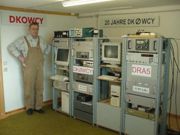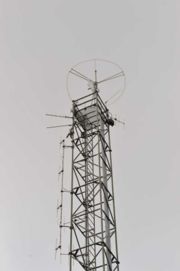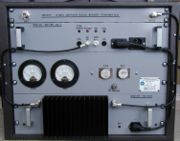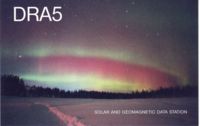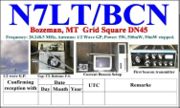Radio propagation beacon
From HFUnderground
A radio propagation beacon is a radio beacon, which is used for investigating the propagation of radio signals. Most radio propagation beacons use amateur radio frequencies. They can be found on HF, VHF, UHF, and microwave frequencies. Microwave beacons are also used as signal sources to test and calibrate antennas and receivers.[1] [2]
Contents |
Transmission characteristics
Most beacons operate in continuous wave (CW or A1A) and transmit their identification (callsign and location). Some of them send long dashes to facilitate signal strength measurement. A small number of beacons transmit Morse code by frequency shift keying (F1A). A few beacons transmit signals in digital modulation modes, like radioteletype (F1B) and PSK31 (G1B).
FT-897, a budget HF tranceiver produced by Yaesu/Vertex, has a programmable beacon mode and is used in some temporary propagation beacon installations.
160 meters beacons
The IARU Region 2 (North and South America) bandplan reserves the range 1999 kHz to 2000 kHz for propagation beacons.
60 meters beacons
In addition to the DARC and RSBG beacon projects on 5195 and 5290 kHz (see below), Eddie Bellerby of UDXF discovered in March 2011 a new CW beacon on 5206 kHz, sending LX0HF, presumably from Luxembourg.[13] Further intelligence indicates that the beacon is operated by Philippe LX2A/LX7I of the Luxembourg Amateur Radio Society.[14] Two more european beacons are listed on 5 MHz, OV1BCN on 5290 kHz, operated by OZ1FJB and OK1IF on 5258.5 kHz from the Czech Republic, though their current status is unclear.
| Callsign | Frequency | Locator | Details |
|---|---|---|---|
| DRA5 | 5195.0 kHz | JO44VQ | DARC |
| LX0HF | 5205.3 kHz | ||
| OK1IF | 5258.5 kHz | JO40HG | |
| GB3RAL | 5290.0 kHz | IO91IN | RSGB |
| GB3WES | 5290.0 kHz | IO84QN | RSGB |
| GB3ORK | 5290.0 kHz | IO89JA | RSGB |
| OV1BCN | 5290.0 kHz | Op OZ1FJB |
10 meters beacons
Most HF radio propagation beacons are found in the 10 meters (28 MHz) frequency band, where they are good indicators of Sporadic E ionospheric propagation. According to IARU bandplans, the following 28 MHz frequencies are allocated to radio propagation beacons:
| IARU Region | Beacon allocations |
|---|---|
| R1 |
|
| R2[3] |
|
| R3 |
|
40 MHz beacons
- The first radio propagation beacon on 40 MHz was OZ7IGY in Jystrup, Denmark (JO55WM) and transmits on 40021 kHz. Transmitted power is 22 W to a dipole antenna. Modulation is F1A keying (frequency Shift Keying), with a shift of 250 Hz. [1]
- The Radio Society of Great Britain has a license for beacon transmissions from GB3RAL (Didcot, UK) on 40050 & 60050 kHz.
6 meters (50 MHz) beacons
In the 6 meters (50 MHz) band, beacons operate in the lower part of the band, in the range 50000 kHz to 50080 kHz. The ARRL bandplan recommends 50060 to 50080 kHz for beacons in the United States. Due to unpredictable and intermittent long distance propagation, usually achieved by a combination of ionospheric conditions, beacons are very important in providing early warning for 50 MHz openings.
4 meters (70 MHz) beacons
General beacon operations
Numerous beacons operate on 70 MHz in recent years. Their main purrpose is to dected the relativley rare and extreme Es (sporadic E) opennings, which exceed 70 MHz.
There is no definite international beacon allocation, due to various countries having different amateur radio allocations in this band. Generally beacons operate near the bottom end (70.000-70.100 MHz).(11) (12). Most respect the RSGB bandplan, staying below 70.050 MHz.
- 70.000-70.050 MHz: UK beacon allocation, including personal beacons on 70.030 MHz
Special beacon allocations
- USA: 70.005 MHz is allocated to the WE9XFT beacon. Transmits from Bedford, VA, under an FCC experimental license issued to Brian Justin, WA1ZMS, with a power of 3 kW.
- Austria: 70.045 MHz is allocated to the OE5QL beacon.
- Hong Kong: 71.757 MHz is allocated to the VR2FOUR beacon.
VHF/UHF beacons
Beacons on 144 MHz and higher frequencies are mainly used to identify tropospheric radio propagation openings. It is not uncommon for VHF and UHF beacons to use directional antennas. Frequency allocations for beacons on VHF and UHF bands vary widely in different ITU/IARU regions and countries.
| Band | Beacon Sub-band (MHz) | ||
|---|---|---|---|
| R1 | R2 | R3 | |
| 2 m | 144.400-144.490 | 144.275–144.300 | Unknown |
| 1.25 m | N/A | 222.050–222.060 | N/A |
| 70 cm | 432.800-432.990 | 432.300–432.400 | Unknown |
| 33 cm | N/A | Varies Locally | N/A |
| 23 cm | 1,296.800-1,296.990 | 1,296.070-1,296.080 | Unknown |
| 13 cm | 2,320.800-2,320.990 | 2,304.300-2,304.400 | Unknown |
The current allocation in the United Kingdom, which also reflects IARU Region 1 recommendations, is the following:[4]
| Band | Beacon allocation (kHz) |
|---|---|
| 4 m | 70,000-70,030 |
| 2 m | 144,400-144,490 |
| 70 cm | 432,800-432,990 |
| 23 cm | 1296,800-1296,990 |
SHF and microwave beacons
In addition to identifying propagation, microwave beacons are also used as signal sources to test and calibrate antennas and receivers. SHF beacons are not as common as beacons on the lower bands, and beacons above the 3 cm (10 GHz) band are unusual.
| Band | Beacon Sub-band (MHz) | ||
|---|---|---|---|
| R1 | R2 | R3 | |
| 9 cm | 3,400.800-3,400.995 | 3,456.300-3,456.400 | Unknown |
| 5 cm | 5,760.800-5,760.995 | 5,760.300-5,760.400 | Unknown |
| 3 cm | 10,368.800-10,368.995 | 10,368.300-10,368.400 | Unknown |
| 1.2 cm | Beacons are rare | ||
Beacon projects
Most radio propagation beacons are operated by individual radio amateurs or amateur radio societies and clubs. As a result, there are frequent additions and deletions to the lists of beacons. There are, however a few major projects coordinated by organizations like the International Telecommunications Union and the International Amateur Radio Union.
IARU Beacon Project
The International Beacon Project (IBP), which is coordinated by the Northern California DX Foundation (NCDXF) and the International Amateur Radio Union (IARU), consists of 18 HF propagation beacons worldwide, which transmit in turns on 14100 kHz, 18110 kHz, 21150 kHz, 24930 kHz, and 28200 kHz. [5] The IARU/NDXF beacons transmit in turns on the five designated frequencies according to the following schedule, which repeats every 3 minutes:
| Slot | DXCC entity | Call | Location | Latitude | Longitude | Grid Sq | 14100 | 18110 | 21150 | 24930 | 28200 | Operator |
|---|---|---|---|---|---|---|---|---|---|---|---|---|
| 01 | United Nations | 4U1UN | New York City | 40º 45' N | 73º 58' W | FN3ØAS | 00.00 | 00.10 | 00.20 | 00.30 | 00.40 | UNRC |
| 02 | Canada | VE8AT | Eureka, Nunavut | 79º 59' N | 85º 57' W | EQ79AX | 00.10 | 00.20 | 00.30 | 00.40 | 00.50 | RAC |
| 03 | United States | W6WX | Mt. Umunhum | 37º 09' N | 121º 54' W | CM97BD | 00:20 | 00.30 | 00:40 | 00.50 | 01:00 | NCDXF |
| 04 | Hawaii | KH6WO | Laie | 21º 38' N | 157º 55' W | BL11AP | 00.30 | 00.40 | 00.50 | 01.00 | 01.10 | (Off) |
| 05 | New Zealand | ZL6B | Masterton | 41º 03' S | 175º 36' E | RE78TW | 00.40 | 00.50 | 01.00 | 01.10 | 01.20 | NZART |
| 06 | Australia | VK6RBP | Rolystone | 32º 06' S | 116º 03' E | OF87AV | 00.50 | 01.00 | 01.10 | 01.20 | 01.30 | WIA |
| 07 | Japan | JA2IGY | Mt. Asama | 34º 27' N | 136º 47' E | PM84JK | 01.00 | 01.10 | 01.20 | 01.30 | 01.40 | JARL |
| 08 | Russia | RR9O | Novosibirsk | 54º 59' N | 82º 54' E | NO14KX | 01.10 | 01.20 | 01.30 | 01.40 | 01.50 | SRR |
| 09 | Hong Kong | VR2B | Hong Kong | 22º 16' N | 114º 09' E | OL72BG | 01.20 | 01.30 | 01.40 | 01.50 | 02.00 | HARTS |
| 10 | Sri Lanka | 4S7B | Colombo | 6º 6' N | 80º 13' E | NJ06CC | 01.30 | 01.40 | 01.50 | 02.00 | 02.10 | RSSL |
| 11 | South Africa | ZS6DN | Pretoria | 25º 54' S | 28º 16' E | KG44DC | 01:40 | 01.50 | 02:00 | 02:10 | 02:20 | ZS6DN |
| 12 | Kenya | 5Z4B | Kariobangi | 1º 15' S | 36º 53' E | KI88KS | 01.50 | 02.00 | 02.10 | 02.20 | 02.30 | ARSC |
| 13 | Israel | 4X6TU | Tel Aviv | 32º 03' N | 34º 46' E | KM72JB | 02:00 | 02:10 | 02:20 | 02.30 | 02:40 | IARC |
| 14 | Finland | OH2B | Lohja | 60º 19' N | 24º 50' E | KP2Ø | 02:10 | 02:20 | 02:30 | 02:40 | 02:50 | SRAL |
| 15 | Madeira | CS3B | Santo da Serra | 32º 43' N | 16º 48' W | IM12OR | 02.20 | 02.30 | 02.40 | 02.50 | 00.00 | ARRM |
| 16 | Argentina | LU4AA | Buenos Aires | 34º 37' S | 58º 21' W | GFØ5TJ | 02:30 | 02:40 | 02:50 | 00.00 | 00:10 | ARC |
| 17 | Peru | OA4B | Lima | 12º 04' S | 76º 57' W | FH17MW | 02.40 | 02.50 | 00.00 | 00.10 | 00.20 | RCP |
| 18 | Venezuela | YV5B | Caracas | 10º 25' N | 66º 51' W | FK6ØNJ | 02:50 | 00.00 | 00:10 | 00:20 | 00:30 | RCV |
ITU sponsored beacons
As part of an International Telecommunications Union-funded project, radio propagation beacons were installed by national authorities at Sveio, Norway (callsign LN2A, 59.60420N - 5.291670E) and at Darwin, Australia (callsign VL8IPS, 12.60420S - 131.29200E). The beacons operated on frequencies 5471.5 kHz, 7871.5 kHz, 10408.5 kHz, 14396.5 kHz, and 20948.5 kHz.[6] Since 2002, there have been no reception reports for these beacons and the relevant ITU web pages have been removed. [7]
| HF Field-Strength measurement campaign
For a number of years, ITU-R Study Group 3 has been promoting a world-wide HF field-strength measurement campaign, the impetus for which arose from WARC HFBC-87 and the request for improved accuracy in HF propagation prediction. At that time, the Study Group recognised that significant improvements in HF propagation prediction methods needed a substantial body of new measurement data and to that end, administrations and organisations were invited to participate in the measurement campaign, either by installing suitable transmitters or by collecting long-term data from appropriate receiving systems. The campaign is specified in Recommendation ITU-R P.845 'HF field-strength measurement' and comprises a world-wide network of transmitters and receivers using coded transmissions on pre-determined frequencies. The reasons for the campaign and the continuing need for participation in it, are underlined in Resolution ITU-R 27 (HF field-strength measurement campaign). So far, regular transmissions are being provided by the Administrations of Australia and Norway. Details of the transmitter in Norway, operated by the Norwegian Telecommunications Authority and Telenor Broadcasting, are given below: Radio Beacon LN2A
Administrations and organizations participating in the work of ITU-R are invited to consider the possibility of participating in the campaign, either through the provision of transmissions or by the collection of field strength measurement data, both in accordance with the specifications given in Recommendation ITU-R P.845. For further details on the campaign, including the availability of a suitable receiving system, please contact the ITU-R Counsellor for Study Group 3 (Dr. Kevin A. Hughes) at ITU Headquarters, in Geneva. The Norwegian Telecommunications Authority and Telenor Broadcasting would be pleased to acknowledge reception reports of LN2A with a QSL card. The contact address is: Norwegian Telecommunications Authority (Att. AYO/TF) |
DARC beacon project
The Deutscher Amateur Radio Club (DARC) sponsors two beacons which transmit from Scheggerott, near Kiel (54.68750N - 9.791670E, JO44VQ). [8] These beacons are DRA5 on 5195 kHz and DK0WCY on 10144 kHz. In addition to identification and location, every 10 minutes these beacons transmit solar, geomagnetic and ionospheric bulletins. Transmissions are in Morse code (CW) for aural reception, RTTY (45 baud 170 Hz at HH+10) and PSK31 (at HH+50). [9] DK0WCY operates also a limited service beacon on 3579 kHz at 0720-0900 and 1600-1900 local time.
RSGB 5 MHz beacon project
The Radio Society of Great Britain (RSGB) operates three radio propagation beacons on 5290 kHz, which transmit in sequence, for one minute each, every 15 minutes. The project includes GB3RAL near Didcot (51.56250N - 1.291670W, IO91IN), GB3WES in Cumbria (54.56250N - 2.6250W, IO84QN) and GB3ORK in the Orkney Islands (59.02080N - 3.208330W, IO89JA).
Beacon GB3RAL, which is located at the Rutherford-Appleton Laboratory, also transmits continuously on 28215 kHz and on a number of low VHF frequencies (40050, 50053, 60053 and 70053 kHz).[10]
Notes and references
- Andy Talbot, G4JNT: "Amateur Beacons", Radio User, ISSN 1748-8117, 3(5), pp.56-58 (May 2008). The article includes the following definition for beacons licensed in the Amateur Radio service: A station in the Amateur Service or Amateur Satellite Service that autonomously transmits in a fixed format, which may include repeated data or information, for the study of propagation, determination of frequency or bearing, or for other experimental purposes.
- Andy Talbot, G4JNT: "Amateur Beacons", Radio User, ISSN 1748-8117, 3(8), pp. 30-33 (August =2008)
- New IARU Region 2 bandplan introduced in January 2008
- Amateur Radio UK VHF Bandplan, Great Yarmouth Radio Club
- International Beacon Project by the Northern California DX Foundation (2008)
- HF 0-20 MHz beacons
- ITU Resolution ITU-R 27/1993: HF Field-strength measurement campaign (PDF)
- Aurora beacon DKØWCY by Deutscher Amateur-Radio-Club e.V.(DARC), 2004.
- Pat Hawker, G3VA: "The DK0WCY/DRA5 Propagation Beacons", Technical Topics Scrapbook - All 50 years, Radio Society of Great Britain, ISBN 9781-9050-8639-9, pp. 98 (2008)
- Mike Willis, G0MJW: "The GB3RAL VHF Beacon cluster", RadCom, 84(04), Radio Society of Great Britain, pp. 65-59, April 2008
- The Four meters website: 70 MHz beacon list
- The Four meters website: RSGB 4m bandplan
- Southgate Amateur Radio Club: Luxembourg 60m beacon LX0HF
- Luxembourg: Une balise sur 60m LX0HF Radioamateurs-Online, March 11, 2011.
See also
- Ionosonde
- Radio beacon
- JG2XA: AN HF Doppler investigation beacon project.
Further reading
- IARU/NDXF International Beacon Project
- Ken Reitz, KS4ZR: "Exploring the World of 10 Meter Beacons", Monitoring Times, May 2007, pages 14-16.
- R.Wilkinson, G6GVI, S.Cooper, GM4AFF, & B. Hansen, OZ2M: "The 70 MHz Beacon List", The Four Metres Website, 2008.
- Martin Harrison, G3USF: Worldwide List of HF Beacons.
- Martin Harrison, G3USF: Worldwide List of 50 Beacons.
- Joost Schuitemaker, ZS5S: List of active HF Amateur Radio Beacons.
- Joost Schuitemaker, ZS5S: Additional HF Beacon Information.
- Joost Schuitemaker, ZS5S: Inactive HF Beacons.
- John Jaminet, W3HMS and Charlie Heisler, K3VDB: "Building a beacon for 2401 MHz", CQ VHF, 10(3), CQ Communications, Inc, ISSN 1085-0708, pages 44–46, 2007.
- Andrew Talbot, G4JNT: Design and building of the 5 MHz beacons, GB3RAL, GB3WES and GB3ORK.
- Andrew Talbot, G4JNT: The Next Generation of Beacons for the 21st century (PPT format).
- UK Microwave Group (UKMuG): UK Amateur Radio & Microwave Beacons.
- GB3VHF – a beacon designed for the 21st Century
- IK0WRB beacon keyer, based on a PIC16F84 microcontroller.
- Aurora Beacon DK0WCY
- OV1BCN: a new HF propagation beacon on 5290.5 kHz.
- BEACONCLUSTER worldwide beacon maps by Richard Kaminski ON4CJU.
| | This article contains textual material from Wikipedia (TM). Wikipedia texts are licensed under the Creative Commons Attribution-Share Alike license. In short: you are free to distribute and modify the text as long as you attribute its author(s) or licensor(s). If you alter, transform, or build upon this work, you may distribute the resulting work only under the same or similar license to this one. Wikipedia article: Radio_propagation_beacon | WP |
This site is a participant in the Amazon Services LLC Associates Program, an affiliate advertising program designed to provide a means for sites to earn advertising fees by advertising and linking to Amazon.com. Some links may be affiliate links. We may get paid if you buy something or take an action after clicking one of these.
